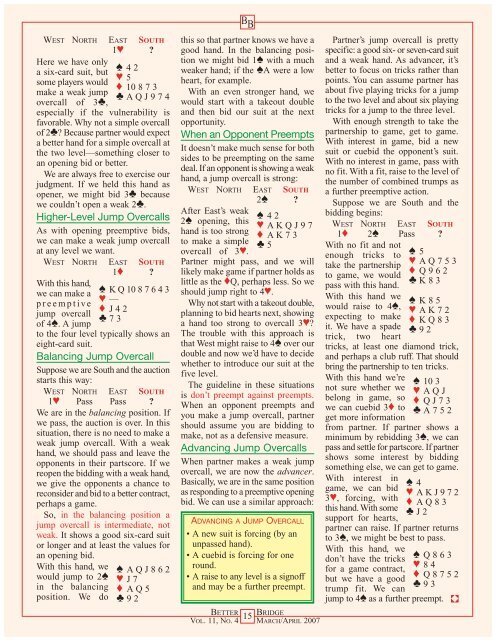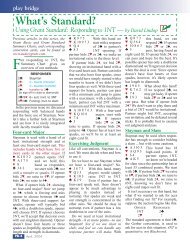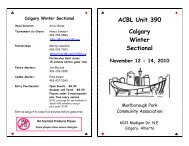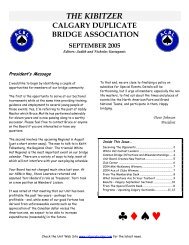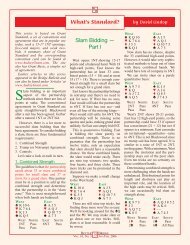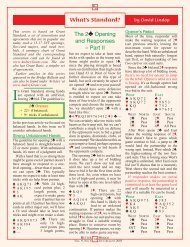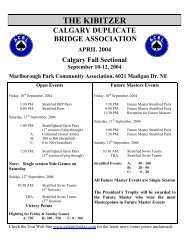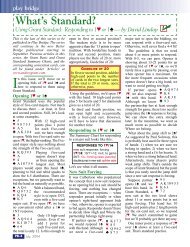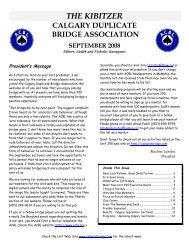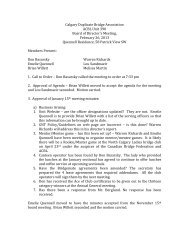What's Standard? The Jump Overcall - Better Bridge
What's Standard? The Jump Overcall - Better Bridge
What's Standard? The Jump Overcall - Better Bridge
Create successful ePaper yourself
Turn your PDF publications into a flip-book with our unique Google optimized e-Paper software.
B B<br />
WEST NORTH EAST SOUTH<br />
1♥ <br />
Here we have only<br />
a six-card suit, but<br />
some players would<br />
make a weak jump<br />
overcall of 3♣,<br />
especially if the vulnerability is<br />
favorable. Why not a simple overcall<br />
of 2♣ Because partner would expect<br />
a better hand for a simple overcall at<br />
the two level—something closer to<br />
an opening bid or better.<br />
We are always free to exercise our<br />
judgment. If we held this hand as<br />
opener, we might bid 3♣ because<br />
we couldn’t open a weak 2♣.<br />
Higher-Level <strong>Jump</strong> <strong>Overcall</strong>s<br />
As with opening preemptive bids,<br />
we can make a weak jump overcall<br />
at any level we want.<br />
WEST NORTH EAST SOUTH<br />
1♦ <br />
With this hand,<br />
we can make a<br />
preemptive<br />
jump overcall<br />
of 4♠. A jump<br />
to the four level typically shows an<br />
eight-card suit.<br />
Balancing <strong>Jump</strong> <strong>Overcall</strong><br />
Suppose we are South and the auction<br />
starts this way:<br />
WEST NORTH EAST SOUTH<br />
1♥ Pass Pass <br />
We are in the balancing position. If<br />
we pass, the auction is over. In this<br />
situation, there is no need to make a<br />
weak jump overcall. With a weak<br />
hand, we should pass and leave the<br />
opponents in their partscore. If we<br />
reopen the bidding with a weak hand,<br />
we give the opponents a chance to<br />
reconsider and bid to a better contract,<br />
perhaps a game.<br />
So, in the balancing position a<br />
jump overcall is intermediate, not<br />
weak. It shows a good six-card suit<br />
or longer and at least the values for<br />
an opening bid.<br />
With this hand, we<br />
would jump to 2♠<br />
in the balancing<br />
position. We do<br />
♠ 4 2<br />
♥ 5<br />
♦ 10 8 7 3<br />
♣ A Q J 9 7 4<br />
♠ K Q 10 8 7 6 4 3<br />
♥ —<br />
♦ J 4 2<br />
♣ 7 3<br />
♠ A Q J 8 6 2<br />
♥ J 7<br />
♦ A Q 5<br />
♣ 9 2<br />
this so that partner knows we have a<br />
good hand. In the balancing position<br />
we might bid 1♠ with a much<br />
weaker hand; if the ♠A were a low<br />
heart, for example.<br />
With an even stronger hand, we<br />
would start with a takeout double<br />
and then bid our suit at the next<br />
opportunity.<br />
When an Opponent Preempts<br />
It doesn’t make much sense for both<br />
sides to be preempting on the same<br />
deal. If an opponent is showing a weak<br />
hand, a jump overcall is strong:<br />
WEST NORTH EAST SOUTH<br />
2♠ <br />
After East’s weak<br />
2♠ opening, this<br />
hand is too strong<br />
to make a simple<br />
overcall of 3♥.<br />
Partner might pass, and we will<br />
likely make game if partner holds as<br />
little as the ♦Q, perhaps less. So we<br />
should jump right to 4♥.<br />
Why not start with a takeout double,<br />
planning to bid hearts next, showing<br />
a hand too strong to overcall 3♥<br />
<strong>The</strong> trouble with this approach is<br />
that West might raise to 4♠ over our<br />
double and now we’d have to decide<br />
whether to introduce our suit at the<br />
five level.<br />
<strong>The</strong> guideline in these situations<br />
is don’t preempt against preempts.<br />
When an opponent preempts and<br />
you make a jump overcall, partner<br />
should assume you are bidding to<br />
make, not as a defensive measure.<br />
Advancing <strong>Jump</strong> <strong>Overcall</strong>s<br />
When partner makes a weak jump<br />
overcall, we are now the advancer.<br />
Basically, we are in the same position<br />
as responding to a preemptive opening<br />
bid. We can use a similar approach:<br />
BETTER<br />
VOL. 11, NO. 4<br />
15<br />
♠ 4 2<br />
♥ A K Q J 9 7<br />
♦ A K 7 3<br />
♣ 5<br />
ADVANCING A JUMP OVERCALL<br />
• A new suit is forcing (by an<br />
unpassed hand).<br />
• A cuebid is forcing for one<br />
round.<br />
• A raise to any level is a signoff<br />
and may be a further preempt.<br />
BRIDGE<br />
MARCH/APRIL 2007<br />
Partner’s jump overcall is pretty<br />
specific: a good six- or seven-card suit<br />
and a weak hand. As advancer, it’s<br />
better to focus on tricks rather than<br />
points. You can assume partner has<br />
about five playing tricks for a jump<br />
to the two level and about six playing<br />
tricks for a jump to the three level.<br />
With enough strength to take the<br />
partnership to game, get to game.<br />
With interest in game, bid a new<br />
suit or cuebid the opponent’s suit.<br />
With no interest in game, pass with<br />
no fit. With a fit, raise to the level of<br />
the number of combined trumps as<br />
a further preemptive action.<br />
Suppose we are South and the<br />
bidding begins:<br />
WEST NORTH EAST SOUTH<br />
1♦ 2♠ Pass <br />
With no fit and not<br />
enough tricks to<br />
take the partnership<br />
to game, we would<br />
pass with this hand.<br />
With this hand we<br />
would raise to 4♠,<br />
expecting to make<br />
it. We have a spade<br />
trick, two heart<br />
tricks, at least one diamond trick,<br />
and perhaps a club ruff. That should<br />
bring the partnership to ten tricks.<br />
With this hand we’re<br />
not sure whether we<br />
belong in game, so<br />
we can cuebid 3♦ to<br />
get more information<br />
from partner. If partner shows a<br />
minimum by rebidding 3♠, we can<br />
pass and settle for partscore. If partner<br />
shows some interest by bidding<br />
something else, we can get to game.<br />
With interest in<br />
game, we can bid<br />
3♥, forcing, with<br />
this hand. With some<br />
support for hearts,<br />
♠ 5<br />
♥ A Q 7 5 3<br />
♦ Q 9 6 2<br />
♣ K 8 3<br />
♠ K 8 5<br />
♥ A K 7 2<br />
♦ K Q 8 3<br />
♣ 9 2<br />
♠ 10 3<br />
♥ A Q J<br />
♦ Q J 7 3<br />
♣ A 7 5 2<br />
♠ 4<br />
♥ A K J 9 7 2<br />
♦ A Q 8 3<br />
♣ J 2<br />
partner can raise. If partner returns<br />
to 3♠, we might be best to pass.<br />
With this hand, we<br />
don’t have the tricks<br />
for a game contract,<br />
but we have a good<br />
trump fit. We can<br />
jump to 4♠ as a further preempt.<br />
♠ Q 8 6 3<br />
♥ 8 4<br />
♦ Q 8 7 5 2<br />
♣ 9 3


